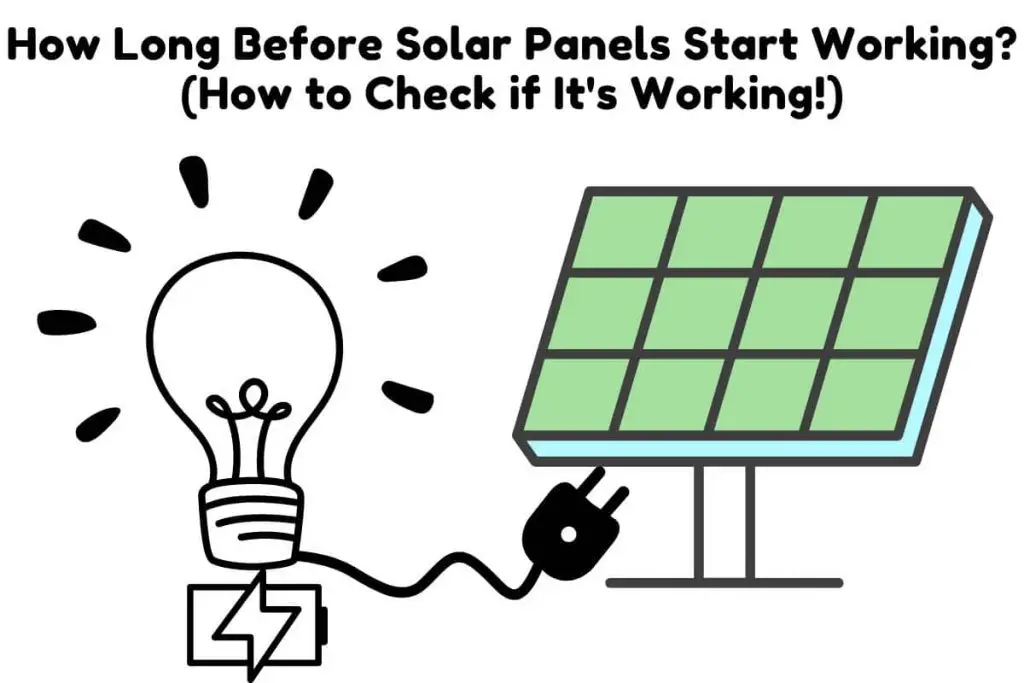One of the advantages of solar energy is the ease and speed with which it can be set up. Solar is by far the easiest renewable energy source to switch to for most homeowners. A complete solar panel system can be fully installed in under three days.
But how long do solar panels take before they start producing electricity? Is it instant or do you have to wait for them to “kick in” so to speak?
In this article, we will look at how solar panels work and some of the ways you can troubleshoot solar panels when they don’t work. By the end of this article, you should be able to diagnose and fix some of the more common faults in a solar panel system.

Do Solar Panels Work Right Away?
Solar panels start supplying electricity as soon as they are exposed to sunlight. Solar panels work through the process of the photovoltaic effect. In terms of this process, energy from sunlight is absorbed and converted into usable electricity.
On a side note! If you’re in need of a reliable and high-performance portable solar panel, We strongly recommend the Jackery SolarSaga 100W Portable Solar Panel (Amazon Link).
With a high conversion efficiency and foldable design, this solar panel is easy to transport and set up, making it perfect for outdoor activities like camping, hiking, and RV trips.

The US solar cell technology used in this panel ensures that you get the most efficient and reliable solar charging possible.
There is also a 60W option that is more affordable (Amazon Link)
One of the main attractions of solar is it produces power immediately. It is just like turning the key in the ignition of your car or turning on a light. As soon as you flip the switch you get light or in the case of solar, electricity.
How To Install Solar Panels
While solar panels work immediately after they are connected, it takes a little longer to get set up, especially for a residential solar system. A simple project like installing solar panels for a pool pump or small workshop can be done in a few hours.
The process for installing solar panels on your home is slightly more complicated. It can take anywhere from three days to three weeks once you’ve found a supplier for the system and a contractor to set it up. Here’s what the process mostly involves.
Siting and design
The first step is assessing if and where you can put up solar panels. Installations can be on the ground or the roof, but they are typically on the roof as this takes up less space. If the roof is not in good condition, a ground-mounted system is preferred.
Designing the system depends on your needs. The most important questions will be how many solar panels are needed and whether batteries are necessary.
Permitting
Unfortunately, you can’t just install solar panels. You have to get permission from your housing authority, and the city. The type of permit depends on what type of system you get as there are different permitting requirements for grid-tie and off-grid systems.
Depending on your town it can take anywhere from a week to more than six weeks to get your permits approved so it is best to get started as soon as possible. You can check how long permitting takes in your area with the Solar TRACE tool from the National Renewable Energy Laboratory. Source
Installation
Once permitting is approved, then installation of the solar panels can start. This is a short process that typically takes less than three days depending on the complexity of the job.
Permission to operate
Once you’ve installed your system, you can’t just go ahead and start using it, however. The city has to inspect and authorize its use. Your utility also has to give you the go-ahead if it is a grid-tie system. This step can take several weeks.
Once it’s approved your solar panels can be turned on and you can start using them. The whole process from location assessment to finally turning the solar panels on can take anywhere from a month to several months. Source
How Do I Know If My Solar Panels Are Working?
The inverter is the first place to assess whether solar panels are producing energy. If the solar panels are working, the inverter should give an indication. This may be a status light or digital display or both. The second place to check, in the case of a grid-tie system is the meter. If the system is working there should be less consumption of utility-supplied electricity.
Most solar systems will have an inverter. Home appliances run on alternate current or AC. Solar panels produce direct current or DC. An inverter converts the DC from a solar panel into the AC that an appliance uses.
An inverter, therefore, gets its input from the solar panels. If the solar panels malfunction, there will be some indication from the inverter. This might be as simple as a red light flashing or an error code on an LCD in a more sophisticated model.
Your electricity meter tells you how much energy you have used. If it shows no difference between when you didn’t have solar and when you installed solar then that is an indication of a possible fault.
If there are batteries in your system you can also check that way. Batteries that are consistently not charging are an indicator that there is a problem with either the solar panels or the batteries.
There is also the option of manually testing the solar panels with a multimeter. Here you have to check whether the panels are producing voltage and current.
Why Are My Solar Panels Not Producing Power?
The most common malfunction with solar panels is not getting direct sunlight. This is more often because of shading. It could also be a result of incorrect orientation, tilt, or positioning.
Where solar panels are installed is by far the biggest factor that influences if and how much energy they will produce. Locating solar panels in the right place comes down to three things:
- Ensuring the solar panels are located away from obstructions like trees or buildings that will reduce if not completely stop solar energy output.
- Make sure the solar panels are facing the correct direction. Solar panels in the northern hemisphere should face south.
- Tilting solar panels so they are perpendicular to the sun produces more energy than having them lay flat. The best angle is between 45 to 60°.
Solar panel positioning should be the first thing to check if there is no power. If the location is good, then the next thing to check would be whether the malfunction is caused by bad connections, defects in the module, or the weather.
